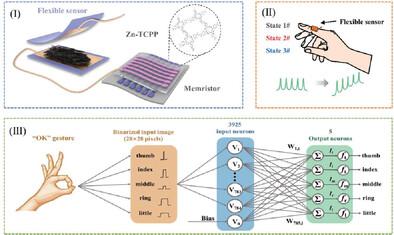当前位置:
X-MOL 学术
›
Adv. Funct. Mater.
›
论文详情
Our official English website, www.x-mol.net, welcomes your
feedback! (Note: you will need to create a separate account there.)
Flexible Zn-TCPP Nanosheet-Based Memristor for Ultralow-Power Biomimetic Sensing System and High-Precision Gesture Recognition
Advanced Functional Materials ( IF 18.5 ) Pub Date : 2024-02-28 , DOI: 10.1002/adfm.202316397 Yilong Wang 1 , Jie Su 1, 2 , Guoyao Ouyang 1 , Sunyingyue Geng 1 , Mengchen Ren 1 , Weiliang Pan 1 , Jing Bian 1 , Minghui Cao 1
Advanced Functional Materials ( IF 18.5 ) Pub Date : 2024-02-28 , DOI: 10.1002/adfm.202316397 Yilong Wang 1 , Jie Su 1, 2 , Guoyao Ouyang 1 , Sunyingyue Geng 1 , Mengchen Ren 1 , Weiliang Pan 1 , Jing Bian 1 , Minghui Cao 1
Affiliation

|
The flexible biomimetic sensory system inspired by biology exhibits learning, memory, and cognitive behavior toward external stimuli, providing a promising direction for the future development of the artificial intelligence industry. In this work, a Zn-TCPP (TCPP: tetrakis (4-carboxyphenyl) porphyrin) based flexible memristor with ultra-low both operating voltage (≈80 mV) and power consumption (0.39 nW) that simulates typical synaptic plasticities, under continuously adjustable ultra-low voltage pulses (50 mV). The synaptic properties are well maintained even when bending 1000 times at a radius of 5 mm. Furthermore, the flexible bionic sensing system integrated with Zn-TCPP based memristor and cotton fibre piezoresistive sensor can remember pressure and deformation current, thus simulate the learning-forgetting-relearning characteristics under mechanical stimuli (power supply = 100 mV). Especially, the system achieves a high recognition rate of 97% for gestures through self-built datasets and neural network calculations and remains at a high level under the influence of 10% Gaussian noise (80%) and 5 mm bending state (91%). Consequently, the ultralow-power flexible biomimetic sensing system shows great potential in the field of integrated artificial intelligence with multiple modules, paving the way for the development of low-power biomimetic robots in the future.
中文翻译:

用于超低功耗仿生传感系统和高精度手势识别的柔性 Zn-TCPP 纳米片忆阻器
受生物学启发的柔性仿生感觉系统表现出对外部刺激的学习、记忆和认知行为,为人工智能产业的未来发展提供了一个有希望的方向。在这项工作中,基于 Zn-TCPP(TCPP:四(4-羧基苯基)卟啉)的柔性忆阻器具有超低工作电压(约 80 mV)和功耗(0.39 nW),可在连续可调的情况下模拟典型的突触可塑性超低电压脉冲 (50 mV)。即使以 5 毫米半径弯曲 1000 次,突触特性也能保持良好。此外,集成Zn-TCPP忆阻器和棉纤维压阻传感器的柔性仿生传感系统可以记住压力和形变电流,从而模拟机械刺激(电源= 100 mV)下的学习-遗忘-再学习特性。特别是,系统通过自建数据集和神经网络计算,对手势实现了97%的高识别率,并且在10%高斯噪声(80%)和5毫米弯曲状态(91%)的影响下仍保持较高水平。因此,超低功耗柔性仿生传感系统在多模块集成人工智能领域显示出巨大潜力,为未来低功耗仿生机器人的发展铺平了道路。
更新日期:2024-02-28
中文翻译:

用于超低功耗仿生传感系统和高精度手势识别的柔性 Zn-TCPP 纳米片忆阻器
受生物学启发的柔性仿生感觉系统表现出对外部刺激的学习、记忆和认知行为,为人工智能产业的未来发展提供了一个有希望的方向。在这项工作中,基于 Zn-TCPP(TCPP:四(4-羧基苯基)卟啉)的柔性忆阻器具有超低工作电压(约 80 mV)和功耗(0.39 nW),可在连续可调的情况下模拟典型的突触可塑性超低电压脉冲 (50 mV)。即使以 5 毫米半径弯曲 1000 次,突触特性也能保持良好。此外,集成Zn-TCPP忆阻器和棉纤维压阻传感器的柔性仿生传感系统可以记住压力和形变电流,从而模拟机械刺激(电源= 100 mV)下的学习-遗忘-再学习特性。特别是,系统通过自建数据集和神经网络计算,对手势实现了97%的高识别率,并且在10%高斯噪声(80%)和5毫米弯曲状态(91%)的影响下仍保持较高水平。因此,超低功耗柔性仿生传感系统在多模块集成人工智能领域显示出巨大潜力,为未来低功耗仿生机器人的发展铺平了道路。















































 京公网安备 11010802027423号
京公网安备 11010802027423号